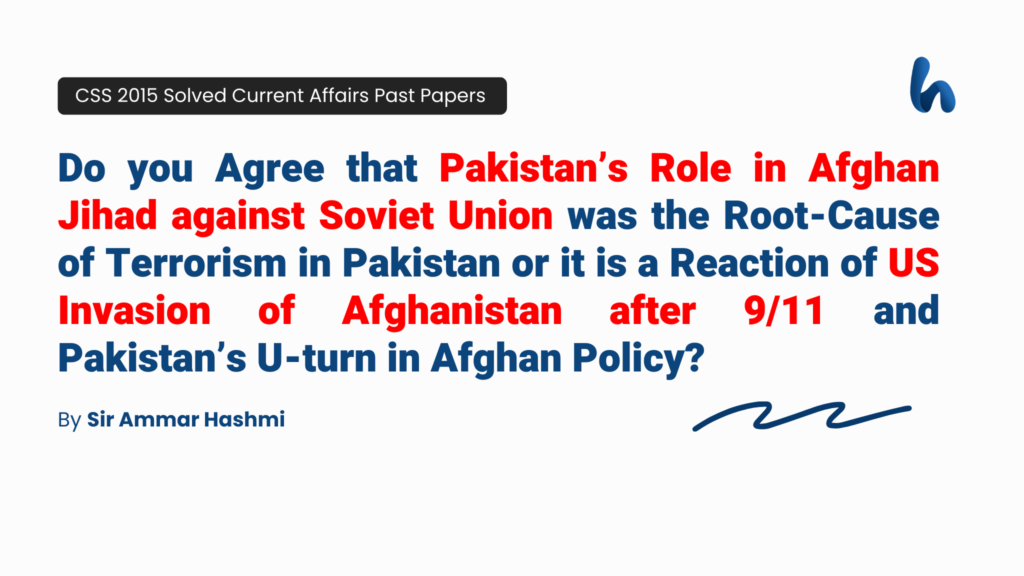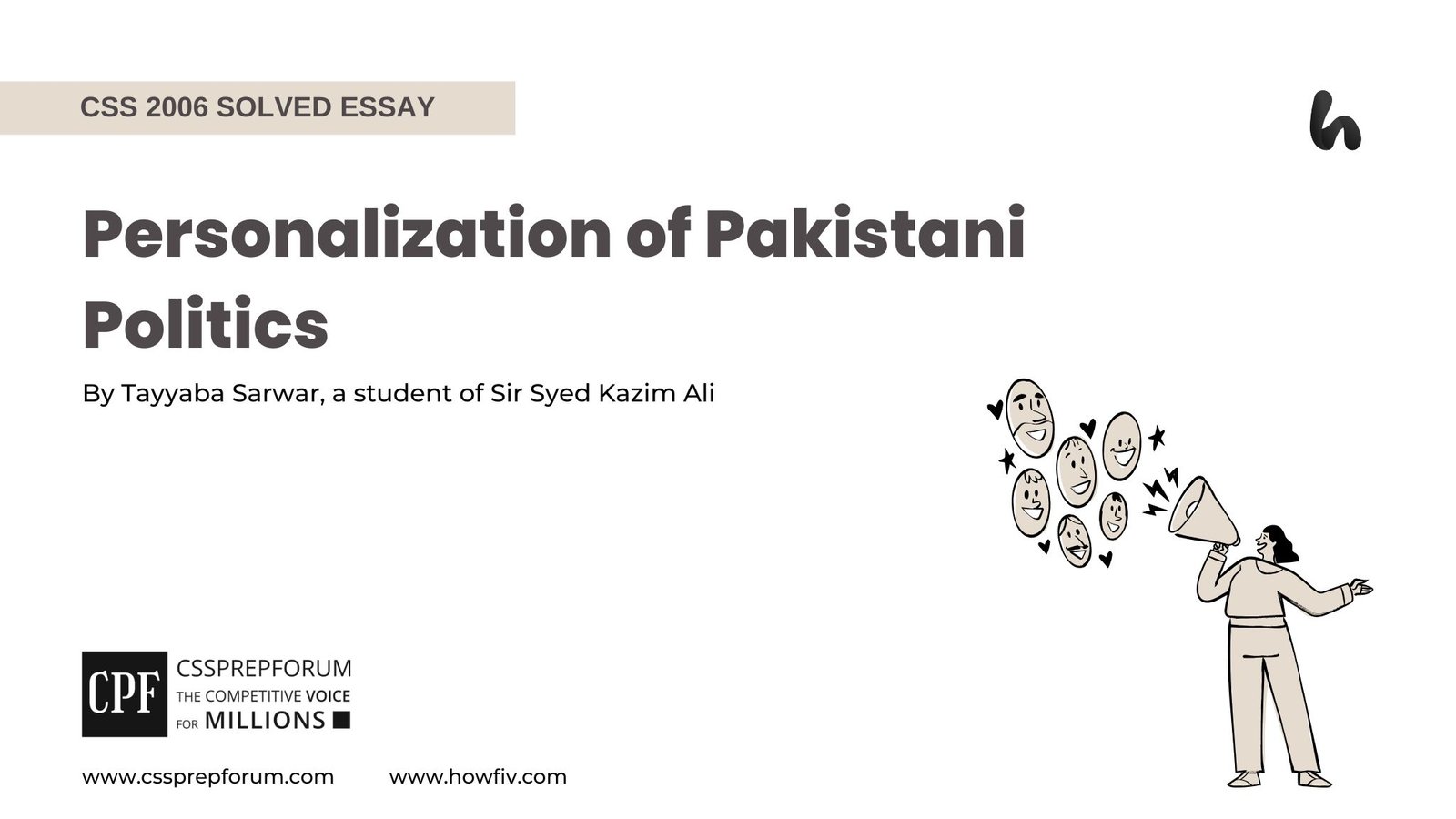CSS 2015 Solved Current Affairs Past Papers | The Pakistan’s Role in Afghan Jihad
The following question of CSS Current Affairs 2015 is solved by Sir Ammar Hashmi, the best Current Affairs Coach, on the guided pattern of Sir Syed Kazim Ali, which he taught to his students, scoring the highest marks in compulsory subjects for years. This solved past paper question is uploaded to help aspirants understand how to crack a topic or question, write relevantly, what coherence is, and how to include and connect ideas, opinions, and suggestions to score the maximum.

Question breakdown
This question is comparative in which the examiner asks about the leading cause of terrorism in Pakistan, and we will touch on both of its causes. After that, we will compare them in a separate critical analysis heading.
Outline
1-Introduction
2-Background: The Evolution of Pakistan’s Security Landscape
3-Seeds of Terrorism: Pakistan’s Role in the Afghan Jihad
- ✓Development of Militant Ecosystem
- ✓Radicalization and Sectarianism
- ✓Post-Jihad Challenges
4-Transforming the Threat: Post-9/11 Policy Shifts
- ✓Policy Reversal and Alienation of Proxies
- ✓Military Operations and Fallout
- ✓Cross-Border Instability
5-Critical Analysis: A Synthesis of Causes
6-Conclusion

Answer to the question
Introduction
Sitting on the beating sphere, Pakistan has always been at the forefront of major geopolitical movements ranging from the Afghan Jihad against the Soviet Union to the post-9/11 War on Terror. Looking at history, Pakistan became a US frontline state against Soviet ambition in Afghanistan during the Cold War, becoming a key ally of the US. This cooperation turned Pakistan into a centre of finance, training, and arms supply to the Afghan Mujahedeen, which multiple foreign powers penned in. However, its unintended consequences were potent: weapons proliferation, extremism, and radical ideology proliferated until a largely undisputable guerrilla infrastructure was created that posed problems undoing once the Soviets left. The erosion was even more dramatic when the instabilities created by the US-led invasion of Afghanistan further destabilized the region. From the start, Pakistan’s shifts in policy toward the Afghan Taliban were alienating former proxies, while veterans of the military operations and the cross-border violence that came with them were wreaking havoc on the country’s stability. In addition, the burgeoning of groups like the Tehrik-i-Taliban Pakistan (TTP) verified that the terrorist threat had become internalized. The debate over terrorism in Pakistan has been heated and impassioned, given the complex interplay of these historical and contemporary factors, and the discussion has generally hinged on the question of what were and are the root causes of terrorism in Pakistan. The Afghan Jihad established the base for militancy, but post-9/11 developments redefined and magnified the threat and turned into a persistent internal crisis. Thus, to analyze this problem, it is crucial to study the interrelation between the geopolitical perspective and the present policies. Therefore, the elimination of terrorism in Pakistan in the long run calls for a perspective that is historical and regional as well as identity and contextual.
Background: The Evolution of Pakistan’s Security Landscape
Geopolitics plays a critical role in defining any country’s security and its role in world events. Pakistan is no exception; it has some of the most strategic geography in the world. Pakistan, which is located between South and Central Asia, was made a frontline state in the Cold War before the Afghan Jihad between 1979 and 1989. It positioned itself as a partner which supports the US, and that gave it an opportunity to supply money, weapons, and training to Afghan Mujahedeen instead of Soviet troops in Afghanistan. However, this period also left a complicated legacy: The infrastructure developed for feeding jihad turned into a hotbed of militancy where weapons were procured without difficulty, and relations with the militants were established. Post-Jihad has also been a problem that only added to the issues for Pakistan, mainly because Pakistan was dealing with being a military society and the phase of radicalization that was imported from the outside. Then, after the 9/11 attack, Pakistan, in an about-face under pressure from the US, decided to give up support to the Afghan Taliban. Thus, this made the former proxies feel betrayed because groups such as Tehrik-i-Taliban Pakistan (TTP) could easily turn and attack the state. Besides threats from homegrown terrorists, the cross-border militancy from the US-led war on Afghanistan affected Pakistan’s frontier regions. These historical and geopolitical changes have inflamed Pakistan to be surrounded by numerous threats from within and outside. Pakistan’s security environment is a classic example of how international and regional systems converge and cascade to generate an apparently inescapable predicament.
Seeds of Terrorism: Pakistan’s Role in the Afghan Jihad
- ✓ Development of Militant Ecosystem
The conflict between the Afghan Mujahideen and the Soviet Union gave birth to a militant organization in Pakistan, which has left an impact on its security and sociopolitical system. From the 1980s, Pakistan was the front-line state of an international jihad against the Soviet forces, mainly financed by the United States and Saudi Arabia. Many hundreds and even thousands of Mujahedeen fighters, including Arab volunteers, were prepared and trained in guerrilla warfare in the camps based in Pakistan’s Ex-FATA region and Khyber Pakhtunkhwa province areas. This influx also led to the availability of highly efficient weapons to be used by transnational militant networks. However, at the same time, it also led to the emergence of networks of migrants beyond the reach of state power. It was a highly militarized society with an armed population carrying small firearms, organized militias, and sophisticated artillery, and it was almost impossible to demilitarize once the Soviets left. Other than that, these camps also functioned as a means of passing through the ideology propagated by radical religious leaders who provided the groundwork for extremism to blossom into religious terrorism. These networks met strategic concerns during the Cold War; however, as of today, these networks have left behind the infrastructure of militant actors whose concerns have been shifting from global to domestic and regional agendas. It then led to the provision of arms and ideology, and violence became the order of the day for many decades, with non-state actors becoming a formidable and destabilising force. It is, therefore, important to understand the militant ecology that has morphed in present-day Pakistan from the Afghan Jihad.
- ✓ Radicalization and Sectarianism
Rather than being a vicious cycle of militancy born out of Afghan Jihad, the latter has amplified militancy, radicalism and sectarianism in Pakistan, which have cemented themselves and become permanent features of the latter’s society and security architecture. In the war period of jihad, a religious school or Madrassa was established to provide ideas and beliefs to the war. These institutions, which in some cases have been funded by foreign funds (especially Saudi money) to propagate a strict version of Islam suitable to the region’s goals, also have the role of radicalising first and second-generation Muslims. They invested their energy and money into these movements that were earlier used to spread unique ideologies which encouraged war and considered jihad as a form of religious obligation that appeals to the oppressed classes of society. These Madaras, over time, became nurseries of extremism and produced, over the years, years of fans devoted to the preachings. Similarly, religious conflict between the Sunni and Shia also intensified due to the geopolitical rivalry between the Saudi Arabian and Iran, which backed different factions in the respective conflict zones. However, this rivalry shifted to the core of Pakistani society, causing severely hostile sectarian conflict in places of worship, communities and even state officials. The Afghan Jihad produced a residue of radicalism and sectarianism that poisoned Pakistani society and produced new lines of conflict. However, the threat of terrorism and national cohesion both deteriorated as militant groups have capitalised on these divisions. Even to this day, the ideological and sectarian reverberations of the Afghan Jihad contribute to Pakistan’s inability to eliminate the extreme and wipe out internal strife.
- ✓ Post-Jihad Challenges
The conclusion of the Afghan Jihad against the Soviet Union left behind for Pakistan several post-conflict issues that define Pakistan’s security situation to this date. One major challenge was integrating thousands of previously combat-experienced locals and foreigners into a society with no fighting role. The absence of reintegration strategies enabled most people to remain involved in armed acts and thus take their policies to the domestic or regional level. Worst still, there was the widespread penetration of the fanatic ideologies that were nurtured in the jihad. Militancy became an instrument which was given the status of religion and had sunk its roots deeply in society and thus paved the way for the emergence of non-state actors. Nevertheless, the infrastructure underlying the jihad—the training camps and arms supply chains—was never dismantled, allowing a ready transfer of these groups into operations on new objectives. These actors deployed their violence inwardly against state institutions and engaged in sectarian conflicts, leading to Pakistan’s internal security suffering. The weak regulatory oversight of tribal areas, porous border with Afghanistan, and a high degree of cross-border exchange of militants, narcotics and arms exacerbated the situation further. When combined, these post-jihad challenges founded a culture of violence and a culture of insecurity in Pakistan and pointed to the impact which outsourced confusion can have on the internal security of a nation. The repercussions of the Afghan Jihad highlighted in a variety of ways and enduring ways its effect on Pakistan’s domestic and regional dynamics.
Transforming the Threat: Post-9/11 Policy Shifts
- ✓ Policy Reversal and Alienation of Proxies
The events of September 11 compelled Pakistan to redefine its relations with various groups that it had, one way or another, supported during the Afghan Jihad. Thus, under pressure from the international community, especially the United States, Pakistan changed its stance and became an ally of the United States in the War on Terror. This shift deprived many militant factions that used to act as allies or proxies of a role and fuelled internal conflict. Those who earlier believed that Pakistan’s establishment would help in countering the regional foe started seeing Pakistan’s deep state as a traitor, which increased attacks on state security forces and properties. This estrangement lessened Pakistan’s control over these foot soldiers and increased the fragmentation of the militant structures, and many of them began to fight against the state. This breakpoint is a clear example of the side effects of using such entities, which left Pakistan, one of the biggest supporters of these groups, on the firing line. This contentious realignment set the tone for the military operations that would shortly be launched.
- ✓ Military Operations and Fallout
In the aftermath of 9/11, Pakistan’s shift in the international spotlight resulted in more relenting military campaigns against militant strongholds from the volatile tribal areas on Pakistan’s northwest frontier. Zarb-e-Azb and Rah-e-Nijat operations were conducted to dismantle the roots of the militants and to bring these lawless regions into some order. As these actions were rather overtly against terrorism, they also had quite a few nasty side effects. Large-scale displacement of people was carried out, and many people were forced into makeshift camps, which overwhelmed the existing national capacity. Public anger generated by civilian deaths and damage to property in the course of the conflict nurtured anti-state sentiments among victims. It inadvertently contributed to the sustenance of the groups that were formed and enlarged by the grievances that would be used in recruitment. Nevertheless, from the point of view of harmonized strategic thinking, the militarized approach was inevitable. However, it did demonstrate the ineffectiveness of force as the primary tool in dealing with entrenched. Give them an example of ideological and socio-economic problems. The war being fought within the state’s territory was as much a measure of the strength of its armed forces as the ability to reconstruct and rebuild the societies torn apart by violence.
- ✓ Cross-Border Instability
Following the military operations in the tribal areas of Pakistan, that relatively weak and unpredictable Afghanistan-Pakistan border became one of the main hotbeds of instability. Attempts to neutralize the insurgent formations remained almost impossible due to the challenging geography of the region and inefficient border control measures that let fighters flee, regroup, and stage even more toxic reprisal. These groups also escaped into the Pak-Afghan border territories, and in doing so, they also disrupted Pakistan’s counter-terrorism operations and became part of the cross-border movement that sustained the violence. Furthermore, the security situation in Afghanistan was so unstable that it had shifted to Pakistan, and here again, in the border areas, already diffused, it contributed to recruitment and radicalization. The failure to establish this frontier revealed that all conflicts in every region are interconnected, and chaos in one zone persists in conflicts at the national and international levels. This dynamic could only generate the most urgent questions regarding the need for collective regional approaches to the problem roots.
Critical Analysis: A Synthesis of Causes
To critically analyse Pakistan’s crisis of multifaceted security results from a historical, geographical and socio-economic configuration of circumstances that have combined over the years to create the environment it is today. Decisions made during the Afghan Jihad, from the nurturing of the militant proxies to support strategic objectives, resulted in the conditions of this instability, sowing the seeds of the long-term legacy of armed extremism. Pakistan is a frontline state located in international conflict zones, starting from the Cold War to the present War on Terror, which exposed the country to external pressures that, at times, led to short-term policy shifts with long-term consequences. However, internal socio-economic factors such as poverty, illiteracy and, above all, the lack of good governance have put these groups of people into disillusionment, which makes them vulnerable to extremist ideologies. Moreover, the elusive Afghan-Pakistan border continues to aid insurgents in cross-border terrorism and counter-terrorism efforts. All in all, these wounded causes initiated a cycle of violence which has intertwined to such an extent that it is almost impossible to distinguish one from the other. This systemic issue would be more than just fixing military hashtags; it would call for solving root causes such as social and economic injustice, radicalising ideology, and lacking interlinked regional frameworks. In order to defeat terrorism and its ability to persist and maintain stability in the long term, Pakistan will have to understand how these pieces of the puzzle interconnect.
Conclusion
In conclusion, several issues afflicting Pakistan’s security and stability are recurrent. They are rooted in history, two outward-bound and a home-bound policy, and internal vulnerabilities, which a holistic and forward-looking response must address. However, military operations and reforms of the policy only demonstrate the resolve of the nation to deal with extremism, but this may not bring a lasting solution now when a lot is required from the socio-economic and governance front to fight extremism. Education and economic development investment are needed to arrest radicalization to achieve peace; transparent institutions help to build public trust and cooperative regional relationships to stabilize cross-border dynamics. By combining short-term crisis management with the longer-term development of equity, inclusion and progress, Pakistan can convert its disadvantages into the seeds of growth and overcome the challenge of long-lasting stability and a brighter future for its citizens.

CSS Solved Past Papers’ Essays
Looking for the last ten years of CSS and PMS Solved Essays and want to know how Sir Kazim’s students write and score the highest marks in the essays’ papers? Then, click on the CSS Solved Essays to start reading them.
CSS Solved Essays
CSS Solved General Science & Ability Past Papers
Want to read the last ten years’ General Science & Ability Solved Past Papers to learn how to attempt them and to score high? Let’s click on the link below to read them all freely. All past papers have been solved by Pakistan’s top CSS GSA coach having the highest score of their students.
General Science & Ability Solved Past Papers












